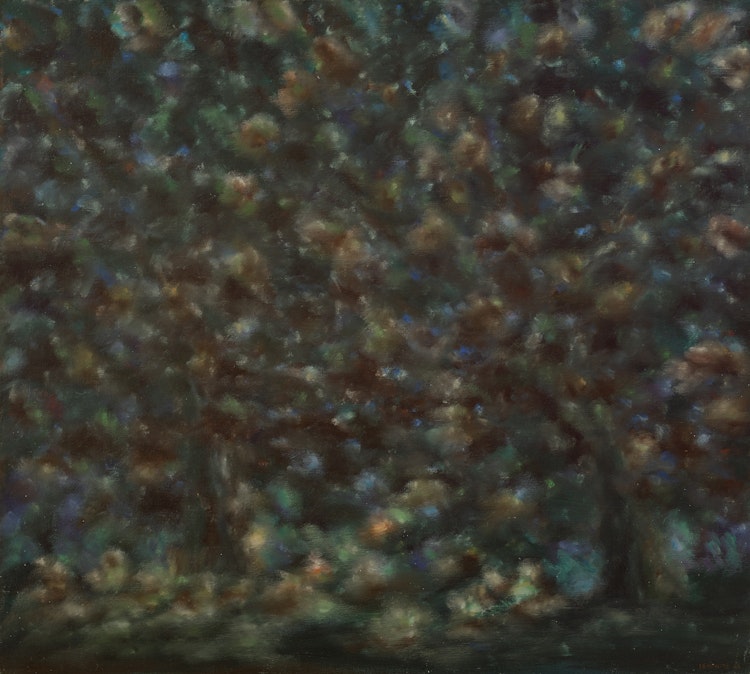Late Summer Evening by Gershon Iskowitz

Gershon Iskowitz
Late Summer Evening
oil on canvas
signed and dated 1962 lower right; Gershon Iskowitz Foundation stamp (Inventory #B19) on the reverse
45 x 50 ins ( 114.3 x 127 cms )
Auction Estimate: $25,000.00 - $35,000.00
Price Realized $17,100.00
Sale date: June 15th 2022
Collection of the artist
Gershon Iskowitz Foundation
Montreal Museum of Fine Arts (partial label)
The Drabinsky Gallery, Toronto
Miriam Shiell Fine Art, Toronto
“More than Money: Architecture and Art at the Bank of Canada”, Ottawa, December 2007, Spring (1962) reproduced page 81
David Burnett, “Iskowitz” [retrospective], Art Gallery of Ontario, 1982, Spring (1962) reproduced page 22
Theodore Allen Heinrich, ‘The intimate cartography of Gershon Iskowitz’s painting’, “artscanada”, May/June 1977, page 13
Ihor Holubizky, “Gershon Iskowitz: Life & Work” [online publication], Art Canada Institute, Toronto, “Late Summer Evening” reproduced page 35
and nature to abstraction in watercolours and oil painting, and by 1960, he had firmly established a studio practice of painting at night and under artificial light.
“Late Summer Evening” and related “tree and forest” paintings, c. 1960-64, are the largest and most ambitious Iskowitz paintings of the period. A comparable painting is “Spring” (1962), collection of the Bank of Canada. Two “Forest” titled paintings, 1960 and 1963-64 are in the collection of the Art Gallery of Ontario. “Vestiges” of observation are evident these works, and in “Late Summer Evening”, the tree trunk in the lower right-hand corner. But Iskowitz’s objective is a structure of light and colour as the leaves dissolve into patches of vivid blue, yellow, and bright green, devising his own form of a “total” painting that continued with the abstract “Parry Sound” ‘variations’ into the mid-1960s. In a 1977 article Iskowitz stated, “I don’t paint what I see but what I have seen.”
“Late Summer Evening” is included in the Key Works in the Art Canada Institute’s Gershon Iskowitz monograph.
We extend our thanks to Dr. Ihor Holubizky for researching this artwork and for contributing the above essay.
Proceeds from this sale will benefit the charitable not-for-profit Gershon Iskowitz Foundation, which awards an annual prize to a professional Canadian visual artist for their ongoing research and artistic production.
Share this item with your friends
Gershon Iskowitz
(1919 - 1988) RCA
Born in Kielce, Poland, in 1919, Gershon Iskowitz immigrated to Canada in 1948 after surviving two Nazi concentration camps (Auschwitz labour camp in Poland and later Buchenwald, near Weimar, Germany). As a child, Iskowitz had an aptitude for art. He created advertisements for his local movie theatre in a section of his family’s living room that his father portioned off to create a small studio.
Following the Nazi occupation of Poland, Iskowitz was placed in the Kielce Ghetto. Once liquidated, Iskowitz was imprisoned in concentration camps in Poland and Germany. While he continued to make drawings during this period only two survive: Condemned (1944-46) and Buchenwald (1944-45). Upon liberation, he lived in the Feldafing Displaced Persons Camp and audited courses at the Academy of Fine Arts in Munich.
Upon receiving a temporary travel document from the Military Government for Germany, issued to stateless people, Iskowitz traveled to Canada via the United States in 1948 where his extended family greeted him at Union Station in Toronto. Until 1954, Iskowitz’s paintings focused on memories from his imprisonment. In the same year, he was included in the Canadian Society of Graphic Art exhibition at the Art Gallery of Ontario (AGO) alongside Painters Eleven artist Oscar Cahén.
By the 1960s Iskowitz’s style transformed from gestural to abstract. He became interested in exploring the Canadian landscape rather than his wartime memories during this period. After exhibiting at Gallery Moos in October 1964, for the first time, Iskowitz formed a close relationship with the owner, Walter Moos. Moos managed Iskowitz’s career and finances from this point forward. After receiving a Canada Council grant in 1967 he flew to Churchill, Manitoba. Entranced by aerial views he saw while in flight, Iskowitz began incorporating this perspective into his art.
Iskowitz was selected to represent Canada alongside Walter Redinger at the Venice Biennale in 1972 where he displayed four of these areal diptychs. In 1982, the AGO put on a retrospective exhibition of Iskowitz’s life work. After the retrospective exhibition had concluded, Iskowitz set up a foundation that would provide financial support to artists through an annual monetary prize, with assistance from Moos.
Literature Source: Ihor Holubizky, Gershon Iskowitz: Life and Work. Toronto: Art Canada Institute, 2018 (https://aci-iac.ca/art-books/gershon-iskowitz)
We extend our thanks to Danie Klein, York University graduate student in art history, for writing and contributing this artist biography.

